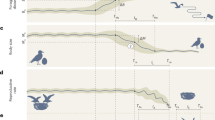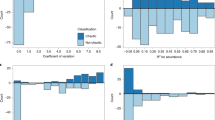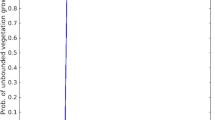Abstract
During the decline to extinction, animal populations may present dynamical phenomena not exhibited by robust populations1,2. Some of these phenomena, such as the scaling of demographic variance, are related to small size3,4,5,6 whereas others result from density-dependent nonlinearities7. Although understanding the causes of population extinction has been a central problem in theoretical biology for decades8, the ability to anticipate extinction has remained elusive9. Here we argue that the causes of a population’s decline are central to the predictability of its extinction. Specifically, environmental degradation may cause a tipping point in population dynamics, corresponding to a bifurcation in the underlying population growth equations, beyond which decline to extinction is almost certain. In such cases, imminent extinction will be signalled by critical slowing down (CSD). We conducted an experiment with replicate laboratory populations of Daphnia magna to test this hypothesis. We show that populations crossing a transcritical bifurcation, experimentally induced by the controlled decline in environmental conditions, show statistical signatures of CSD after the onset of environmental deterioration and before the critical transition. Populations in constant environments did not have these patterns. Four statistical indicators all showed evidence of the approaching bifurcation as early as 110 days (∼8 generations) before the transition occurred. Two composite indices improved predictability, and comparative analysis showed that early warning signals based solely on observations in deteriorating environments without reference populations for standardization were hampered by the presence of transient dynamics before the onset of deterioration, pointing to the importance of reliable baseline data before environmental deterioration begins. The universality of bifurcations in models of population dynamics suggests that this phenomenon should be general10,11,12.
This is a preview of subscription content, access via your institution
Access options
Subscribe to this journal
Receive 51 print issues and online access
$199.00 per year
only $3.90 per issue
Buy this article
- Purchase on Springer Link
- Instant access to full article PDF
Prices may be subject to local taxes which are calculated during checkout




Similar content being viewed by others
References
Fagan, W. F. & Holmes, E. E. Quantifying the extinction vortex. Ecol. Lett. 9, 51–60 (2006)
Oborny, B., Meszéna, G. & Szabo, G. Dynamics of populations on the verge of extinction. Oikos 109, 291–296 (2005)
Ludwig, D. The distribution of population survival times. Am. Nat. 147, 506–526 (1996)
Lande, R. Demographic stochasticity and Allee effect on a scale with isotropic noise. Oikos 83, 353–358 (1998)
Drake, J. M. Density-dependent demographic variation determines extinction rate of experimental populations. PLoS Biol. 3, e222 (2005)
Melbourne, B. A. & Hastings, A. Extinction risk depends strongly on factors contributing to stochasticity. Nature 454, 100–103 (2008)
Takimoto, G. Early warning signals of demographic regime shifts in invading populations. Popul. Ecol. 51, 419–426 (2009)
Kendall, D. G. On the generalized “birth-and-death” process. Ann. Math. Stat. 19, 1–15 (1948)
Ludwig, D. Is it meaningful to estimate a probability of extinction? Ecology 80, 298–310 (1999)
Dakos, V. et al. Slowing down as an early warning signal for abrupt climate change. Proc. Natl Acad. Sci. USA 105, 14308–14312 (2008)
Scheffer, M. Critical Transitions in Nature and Society (Princeton Univ. Press, 2009)
Scheffer, M. et al. Early-warning signals for critical transitions. Nature 461, 53–59 (2009)
Baillie J. E. M., Hilton-Taylor C., Stuart S. N., eds. 2004 IUCN Red List of Threatened Species: A Global Species Assessment 10–104 (IUCN, 2004)
Brook, B. W., Sodhi, N. S. & Bradshaw, C. J. A. Synergies among extinction drivers under global change. Trends Ecol. Evol. 23, 453–460 (2008)
Hallam, T. G. & Clark, C. E. Non-autonomous logistic equations as models of populations in a deteriorating environment. J. Theor. Biol. 93, 303–311 (1981)
Jagers, P. & Zhunwei, L. Branching processes with deteriorating random environments. J. Appl. Probab. 39, 395–401 (2002)
Lande, R., Engen, S. & Sæther, B. E. Stochastic Population Dynamics in Ecology and Conservation 1–118 (Oxford Univ. Press, 2003)
Fussmann, G. F., Ellner, S. P., Shertzer, K. W. & Hairston, N. G., Jr Crossing the Hopf bifurcation in a live predator-prey system. Science 290, 1358–1360 (2000)
Becks, L., Hilker, F. M., Malchow, H., Jürgens, K. & Arndt, H. Experimental demonstration of chaos in a microbial food web. Nature 435, 1226–1229 (2005)
Carpenter, S. R. & Brock, W. A. Rising variance: a leading indicator of ecological transition. Ecol. Lett. 9, 311–318 (2006)
Wissel, C. A universal law of the characteristic return time near thresholds. Oecologia 65, 101–107 (1984)
van Nes, E. H. & Scheffer, M. Slow recovery from perturbations as a generic indicator of a nearby catastrophic shift. Am. Nat. 169, 738–747 (2007)
Guttal, V. & Jayaprakash, C. Changing skewness: an early warning signal of regime shifts in ecosystems. Ecol. Lett. 11, 450–460 (2008)
Dakos, V., van Nes, E. H., Donangelo, R., Fort, H. & Scheffer, M. Spatial correlation as leading indicator of catastrophic shifts. Theor. Ecol. 3, 163–174 (2010)
McSharry, P. E., Smith, L. A. & Tarassenko, L. Prediction of epileptic seizures: are nonlinear methods relevant? Nature Med. 9, 241–242 (2003)
Kéfi, S. et al. Spatial vegetation patterns and imminent desertification in Mediterranean arid ecosystems. Nature 449, 213–217 (2007)
Lenton, T. M. et al. Tipping elements in the Earth’s climate system. Proc. Natl Acad. Sci. USA 105, 1786–1793 (2008)
Hastings, A. & Wysham, D. Regime shifts in ecological systems can occur with no warning. Ecol. Lett. 13, 464–472 (2010)
Drake, J. M. Extinction times in experimental populations. Ecology 87, 2215–2220 (2006)
Biggs, R., Carpenter, S. R. & Brock, W. A. Turning back from the brink: detecting an impending regime shift in time to avert it. Proc. Natl Acad. Sci. USA 106, 826–831 (2009)
Acknowledgements
G. Fussman, A. Hastings, A. Kramer, R. Hall, A. Park and T. Stratmann provided comments on earlier versions of this paper. A. Silletti assisted with the preparation of the manuscript. This research was supported by funding from the Odum School of Ecology, a University of Georgia Faculty Research Grant and funding from the University of South Carolina.
Author information
Authors and Affiliations
Contributions
J.M.D. and B.D.G. jointly conceived the study. B.D.G. performed the experiment. J.M.D. performed the analysis and wrote the paper.
Corresponding author
Ethics declarations
Competing interests
The authors declare no competing financial interests.
Supplementary information
Supplementary Information
This file contains Supplementary Information comprising Appendix I: Experimental and analytical methods, Appendix II: Extinction time distribution including Supplementary Figure 1 with legend and Appendix III: Critical slowing down and early warning signals in single population trajectories including Supplementary Figures 1-11 with legends. Additional references are also included. (PDF 2125 kb)
Rights and permissions
About this article
Cite this article
Drake, J., Griffen, B. Early warning signals of extinction in deteriorating environments. Nature 467, 456–459 (2010). https://doi.org/10.1038/nature09389
Received:
Accepted:
Published:
Issue Date:
DOI: https://doi.org/10.1038/nature09389
This article is cited by
-
Diatom evidence of ecological change in a deep subtropical reservoir (southeastern China) over the past 60 years
Journal of Paleolimnology (2024)
-
A predictive timeline of wildlife population collapse
Nature Ecology & Evolution (2023)
-
Early warning signals have limited applicability to empirical lake data
Nature Communications (2023)
-
Data-driven detection of critical points of phase transitions in complex systems
Communications Physics (2023)
-
Nitrogen Reduction Causes Shifts in Winter and Spring Phytoplankton Composition and Resource Use Efficiency in a Large Subtropical Lake in China
Ecosystems (2023)
Comments
By submitting a comment you agree to abide by our Terms and Community Guidelines. If you find something abusive or that does not comply with our terms or guidelines please flag it as inappropriate.



